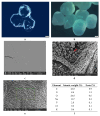Simultaneous Encapsulation of Probiotic Bacteria (Lactococcus lactis, and Lactiplantibacillus plantarum) in Calcium Alginate Hydrogels
- PMID: 39852005
- PMCID: PMC11765212
- DOI: 10.3390/gels11010034
Simultaneous Encapsulation of Probiotic Bacteria (Lactococcus lactis, and Lactiplantibacillus plantarum) in Calcium Alginate Hydrogels
Abstract
Encapsulation in alginate hydrogel microspheres is an effective method for protecting and improving the survival of lactic acid bacteria in different environments. This research aims to expand the knowledge about the structure/property relationship of calcium alginate microspheres loaded with a mixture of autochthonous probiotic bacteria (Lactococcus lactis and Lactiplantibacillus plantarum). A novel hydrogel formulation (FORMLAB) was prepared by ionic gelation and the molecular interactions between the FORMLAB constituents, surface morphology, structure, swelling degree, and release profile were characterized. The simultaneous encapsulation of two bacterial cultures in the same compartment does not diminish their viability. The binding of calcium ions to bacterial cells creates favorable conditions for the propagation of the encapsulated bacteria. The molecular interactions between the FORMLAB constituents are complex, involving mainly hydrogen bonds and electrostatic interactions. With a very high degree of swelling followed by low crosslinking, the surface of the microspheres covered with bacterial cells and diffusion through the hydrogel matrix allow for the delivery of probiotics at the right time. The findings suggest that bacterial cells are efficiently delivered from calcium alginate microspheres, offering promising applications in the development of functional foods, especially in cheese production.
Keywords: Lactiplantibacillus plantarum; Lactococcus lactis; calcium alginate hydrogel; simultaneous encapsulation.
Conflict of interest statement
The authors declare no conflicts of interest.
Figures








Similar articles
-
Microencapsulation of probiotics in hydrogel particles: enhancing Lactococcus lactis subsp. cremoris LM0230 viability using calcium alginate beads.Food Funct. 2016 Apr;7(4):1797-804. doi: 10.1039/c5fo00801h. Food Funct. 2016. PMID: 26611443
-
Lactoferrin-alginate-pectin composite hydrogel: Enhancing Lactobacillus plantarum B072 survival, density and biofilm formation.Int J Biol Macromol. 2025 May;308(Pt 2):141983. doi: 10.1016/j.ijbiomac.2025.141983. Epub 2025 Mar 11. Int J Biol Macromol. 2025. PMID: 40081688
-
Survival and Behavior of Encapsulated Probiotics (Lactobacillus plantarum) in Calcium-Alginate-Soy Protein Isolate-Based Hydrogel Beads in Different Processing Conditions (pH and Temperature) and in Pasteurized Mango Juice.Biomed Res Int. 2019 Feb 13;2019:9768152. doi: 10.1155/2019/9768152. eCollection 2019. Biomed Res Int. 2019. PMID: 30895197 Free PMC article.
-
Encapsulation of two fermentation agents, Lactobacillus sakei and calcium ions in microspheres.Colloids Surf B Biointerfaces. 2021 Jan;197:111387. doi: 10.1016/j.colsurfb.2020.111387. Epub 2020 Oct 7. Colloids Surf B Biointerfaces. 2021. PMID: 33049659
-
Probiotics in tilapia (Oreochromis niloticus) culture: Potential probiotic Lactococcus lactis culture conditions.J Biosci Bioeng. 2022 Mar;133(3):187-194. doi: 10.1016/j.jbiosc.2021.11.004. Epub 2021 Dec 15. J Biosci Bioeng. 2022. PMID: 34920949 Review.
References
-
- Kondrotiene K., Zavistanaviciute P., Aksomaitiene J., Novoslavskij A., Malakauskas M. Lactoccus lactis in Dairy Fermentation—Health-Promoting and Probiotic Properties. Fermentation. 2024;10:16. doi: 10.3390/fermentation10010016. - DOI
-
- Tripathi M.K., Giri S.K. Probiotic functional foods: Survival of probiotics during processing and storage. J. Funct. Foods. 2014;9:225–241. doi: 10.1016/j.jff.2014.04.030. - DOI
Grants and funding
LinkOut - more resources
Full Text Sources

